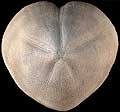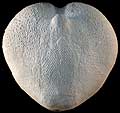The Echinoid Directory
Gibbaster Gauthier, 1888, p. 381
[=Isomicraster Lambert, 1901, p. 959; type species Micraster senonensis Lambert 1895, p. 239; = Pseudoepiaster Seunnes, 1888, p. 803 (nomen nudum) ]
| Diagnostic Features |
|
|---|---|
| Distribution | Upper Cretaceous (Turonian to Campanian), Europe, former Soviet Union, North Africa. |
| Name gender | masculine |
| Type | Micraster fastigatus Gauthier, 1887, p. 237 (= Micraster gibbus Desor, 1858, p. 365 non Lamarck, 1816), by subsequent designation of Lambert & Thiery, 1924, p. 483. |
| Species Included |
|
| Classification and/or Status |
|
| Remarks |
|




